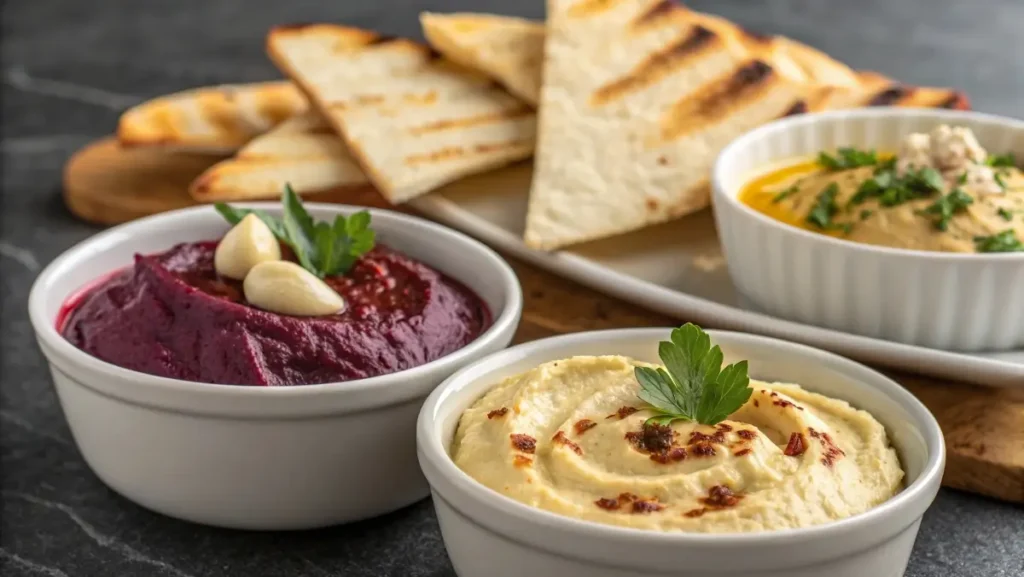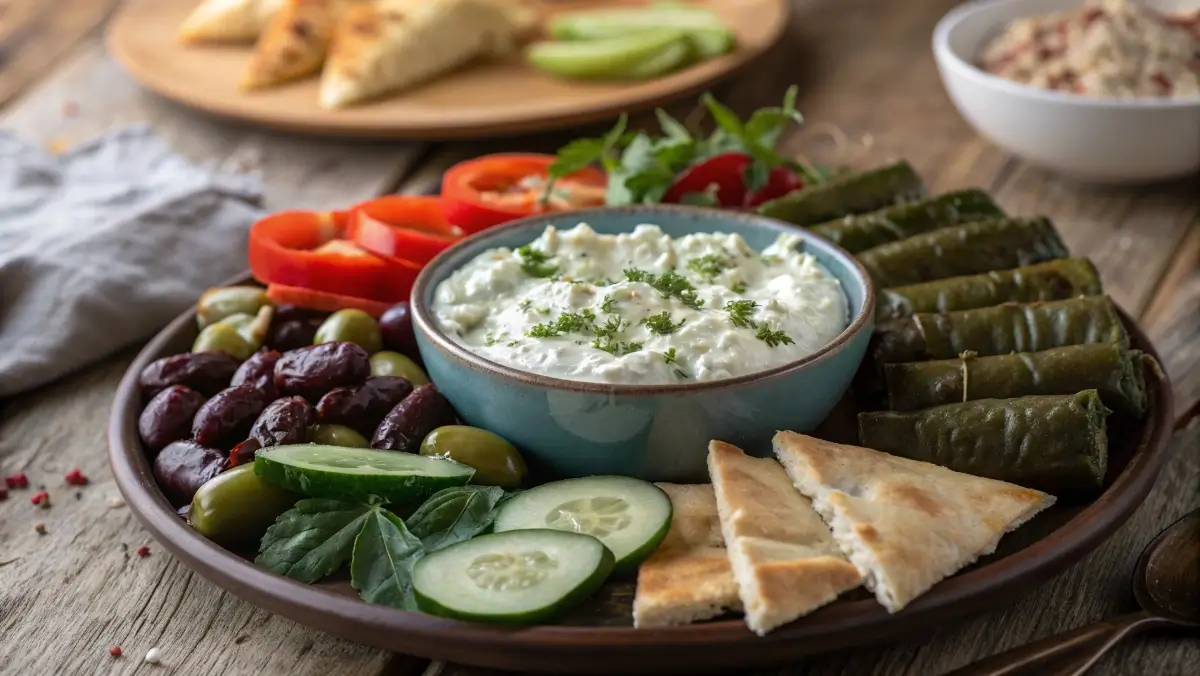15 Best Greek Side Dishes to Elevate Any Mediterranean Meal
Greek cuisine is celebrated worldwide for its bold flavors, fresh ingredients, and harmonious balance between taste and nutrition. While the hearty mains are undeniably delicious, it’s often the vibrant, colorful, and deceptively simple Greek side dishes that steal the show. From crisp salads to savory dips and roasted vegetables, these sides add texture, freshness, and depth to any meal. Whether you’re hosting a Mediterranean-themed dinner, preparing homemade gyros, or just craving a light and wholesome vegetable dish, there’s a Greek side to satisfy every palate.
From tangy tzatziki and crispy spanakopita to roasted lemon potatoes and traditional Greek salads, this guide dives deep into the most authentic and delicious Greek side dishes you can serve at home. You’ll also discover which sides pair best with gyros, how to build a Greek platter, and even learn how to compliment a meal like a local. Don’t miss our comforting bowl of Greek Lemon Rice Soup to kick off the Mediterranean vibes.
Table of Contents
The Essence of Greek Cuisine and Traditional Greek Side Dishes
What Defines Greek Side Dishes in Mediterranean Cooking?
Greek side dishes are an integral part of the Hellenic dining experience. Unlike in many Western meals where side dishes are an afterthought, Greek cuisine treats them with equal importance to mains. These sides are fresh, simple, seasonal, and typically include combinations of olive oil, lemon, oregano, feta cheese, and a mix of grilled or raw vegetables.
Many side dishes in Greek cooking follow the mezze concept—a collection of small plates meant to be shared. This communal approach makes meals more engaging, conversational, and satisfying.
Key characteristics of Greek side dishes:
| Feature | Description |
|---|---|
| Ingredients | Olive oil, lemon, oregano, feta, cucumbers, tomatoes, spinach, phyllo dough |
| Methods | Roasted, grilled, fresh/raw, baked |
| Texture | Crunchy (phyllo), creamy (tzatziki), juicy (tomatoes, cucumbers) |
| Flavors | Bright, tangy, herbaceous, savory |
These dishes are designed not only to balance the main course but to enhance and even compete with it in taste and presentation.
Common Ingredients Found in Traditional Greek Recipes
The essence of any authentic Greek side dish lies in its ingredients. Greek cooking is known for keeping things simple and letting each element shine. Here’s a look at some of the staple ingredients you’ll find across nearly every traditional Greek side dish:
- Olive Oil: The cornerstone of Greek cuisine. Used in everything from salads to baked dishes.
- Lemon Juice: Brings brightness and acidity to sides like roasted potatoes and dips.
- Feta Cheese: Crumbly and salty, it tops everything from salads to baked veggies.
- Greek Yogurt: Thick and creamy, it’s the base for dips like tzatziki.
- Cucumbers & Tomatoes: Always fresh, always present.
- Oregano & Dill: Essential herbs that give Greek food its unique aroma.
- Garlic & Onions: Used to build flavor in both cooked and raw preparations.
- Phyllo Dough: Flaky pastry used in savory pies like spanakopita.
Discover great ideas like Honey Greek Yogurt, which adds a creamy, cooling contrast to spicy or herb-heavy dishes.
Popular Greek Side Dishes That Everyone Loves
Classic Tzatziki and Its Refreshing Flavors
Tzatziki is a cornerstone of Greek cuisine—creamy, tangy, and refreshing. This yogurt-based dip is traditionally made with Greek yogurt, cucumber, garlic, olive oil, fresh dill, and a splash of lemon juice. It’s not just a sauce—it’s a versatile side that can be used as a dip for pita bread, a topping for grilled meats, or a spread in wraps like gyros.
Tzatziki’s appeal lies in its balance of richness from the yogurt and brightness from the lemon and cucumber. It’s served cold, making it especially perfect for warm-weather meals or as a contrast to spicy or savory mains.

How to Make Authentic Tzatziki:
| Ingredient | Amount |
|---|---|
| Greek Yogurt | 1 cup |
| Grated Cucumber (drained) | ½ cup |
| Garlic (minced) | 1–2 cloves |
| Lemon Juice | 1 tablespoon |
| Olive Oil | 1 tablespoon |
| Dill or Mint | 1 tablespoon, chopped |
| Salt & Pepper | To taste |
Tzatziki is also incredibly adaptable—some regions of Greece add mint instead of dill, and others stir in a touch of vinegar. No matter the variation, it remains one of the most loved Greek side dishes for its simplicity and incredible flavor.
Spanakopita (Spinach Pie): A Savory Favorite
If there’s one baked dish that defines Greek side offerings, it’s spanakopita. This flaky, savory spinach pie combines earthy greens, tangy feta cheese, and layers of crispy phyllo dough. It’s equally delicious as a standalone side or part of a mezze platter.
What makes Spanakopita so special?
- Phyllo dough: Thin, crisp, and buttery when baked.
- Filling: A mix of sautéed spinach, green onions, dill, and feta.
- Versatility: Can be served hot or cold, as a triangle, a square, or a roll.
Quick Spanakopita Tip: Don’t skimp on olive oil or melted butter when brushing phyllo layers—this gives it the golden crunch people crave.
Spanakopita pairs beautifully with dishes like moussaka, grilled lamb, or as a centerpiece in vegetarian spreads. It’s a perfect example of how Greek cuisine turns humble ingredients into something unforgettable.
Popularity at Greek Gatherings
Whether you’re dining at a Greek taverna or preparing a homemade feast, tzatziki and spanakopita almost always make the table. These sides are not only staples in Greek homes but also crowd-pleasers among international audiences.
Why these dishes work:
- They balance heavy meat dishes like souvlaki or moussaka.
- They offer vegetarian-friendly options.
- They’re easy to make ahead and serve at room temperature.
Looking for inspiration? Try Tasty Phyllo Dough Appetizer Ideas to expand beyond traditional spanakopita with creative twists.
Greek Side Dishes That Pair Perfectly with Gyros
Must-Try Sides That Complement Gyros
When it comes to building the perfect gyro plate, what surrounds the gyro is just as important as the meat itself. The most complementary Greek side dishes bring contrast and balance—freshness against the savory richness of lamb or chicken, crunch against the softness of pita bread, and tangy elements to cut through the fat.
Here are the best Greek side dishes to serve with gyros:
- Tzatziki Sauce – Always a classic, either inside or beside the gyro.
- Greek Fries – Crispy potatoes topped with crumbled feta, oregano, and a squeeze of lemon.
- Lemon-Roasted Potatoes – Rich in flavor and perfect for scooping up leftover gyro juices.
- Horiatiki Salad (Village Salad) – Tomatoes, cucumbers, red onions, olives, and feta in olive oil and oregano. No lettuce.
- Dolmades (Stuffed Grape Leaves) – Mildly tangy and soft, perfect as a contrasting side bite.
- Marinated Olives – Add briny intensity to balance the rich meats.
Sample Gyro Plate Setup:
| Component | Description |
|---|---|
| Main | Grilled lamb or chicken gyro in warm pita |
| Side 1 | Tzatziki and sliced cucumbers |
| Side 2 | Greek lemon potatoes or fries |
| Side 3 | Horiatiki salad |
| Optional Add-on | Dolmades or marinated olives |
Each item serves a purpose—cooling the palate, adding texture, or enhancing flavors through acidity or salt.
Best Bread and Sauce Combinations with Gyros
While the protein gets the spotlight, the supporting players—pita and sauces—can make or break a gyro meal. Choosing the right bread and sauce pairing elevates your plate from fast food to feast.
Pita Bread Tips:
- Go for soft, non-pocket pita—ideal for wrapping around fillings without tearing.
- Lightly toast or grill for added texture and aroma.
- Brush with olive oil and sprinkle with sea salt or oregano for extra flavor.
Sauces That Steal the Show:
- Tzatziki – Creamy, garlicky, and a must-have.
- Skordalia – A thick, bold garlic and potato dip.
- Melitzanosalata – Smoky eggplant dip for a vegan touch.
- Tyrokafteri – A spicy feta dip with a creamy, peppery kick.
For vegetarians or those mixing in plant-based gyros, these sauces also double as flavorful bases or spreads.
Don’t miss our comforting Greek Lemon Rice Soup, a soothing complement to meaty gyros, especially during colder months.
Vegetable-Based Greek Side Dishes
Roasted Lemon Potatoes and Mediterranean Veggies
When it comes to Greek side dishes, no category is as deeply satisfying—or as versatile—as vegetable-based options. These dishes often serve as the glue that ties together a Greek meal, offering everything from crunchy, roasted textures to fresh, herbaceous notes that balance heavier meats and seafood.

One standout is the iconic Greek lemon potatoes. These roasted delights are a masterclass in flavor:
- Ingredients: Yukon gold or russet potatoes, olive oil, lemon juice, garlic, oregano, and a touch of chicken broth.
- Method: Potatoes are baked in their marinade, soaking up every bit of lemony, herby goodness before crisping up at the edges.
Why They Work So Well:
- Their zesty, savory flavor profile complements grilled meats like lamb or souvlaki.
- The texture is crisp on the outside, soft on the inside—exactly what you want from a roasted side.
Bonus Veggie Sides to Try:
| Dish | Key Ingredients | Best With |
|---|---|---|
| Briam | Zucchini, potatoes, tomatoes, onions | Roasted chicken or lamb |
| Gigantes Plaki | Giant white beans, tomato sauce, herbs | Flatbread or feta |
| Roasted Peppers | Bell peppers, olive oil, garlic | Grilled meats or pita |
| Greek Green Beans (Fasolakia) | Green beans, tomatoes, olive oil | Fish or vegetarian mains |
Each of these dishes carries the same Greek signature: fresh, seasonal produce elevated by olive oil, herbs, and slow roasting or stewing methods.
Greek Salads: Horiatiki, Lahanosalata, and More
Greek salads aren’t just an afterthought—they’re a central part of the Mediterranean diet and make excellent side dishes for almost any main. But there’s more to Greek salads than just a bowl of lettuce and tomatoes.
1. Horiatiki (Traditional Greek Salad):
- Tomatoes, cucumbers, Kalamata olives, red onions, feta cheese, and green bell pepper.
- No lettuce, ever.
- Dressed in extra virgin olive oil, dried oregano, and sea salt.
2. Lahanosalata (Greek Cabbage Salad):
- A shredded cabbage salad with carrots, olive oil, lemon juice, and salt.
- Crunchy and tangy—great for grilled fish or meats.
3. Maroulosalata (Lettuce Salad):
- Romaine lettuce, green onions, dill, and a vinegar-oil dressing.
- A lighter side option with fresh flavor.
4. Beet Salad with Skordalia:
- Boiled beets paired with garlic-potato dip.
- Earthy, slightly sweet, and beautifully vibrant.
What makes these salads special is their lack of complexity. No store-bought dressings, no excessive toppings. Just honest ingredients, served fresh and dressed simply.
Don’t miss our Gluten-Free Summer Salads for veggie-packed options that bring the same Mediterranean flair without the gluten.
How Vegetables Anchor the Greek Table
In Greece, vegetables often take center stage, even when meat is present. Many meals are built around vegetable sides, making them hearty enough for vegetarians and essential for omnivores.
From slow-cooked stews to chilled salads, these Greek side dishes demonstrate how vegetables—when cooked the right way—can be every bit as satisfying as a main course.
Check out Honey Greek Yogurt as a cooling, creamy accompaniment to roasted veggie dishes for added contrast in texture and taste.
Traditional Greek Platters and Mezze Spreads
What’s in a Typical Greek Platter?
Greek platters aren’t just assortments of food—they’re a joyful expression of culture, togetherness, and Mediterranean culinary diversity. Whether you’re hosting a party or building a family-style dinner, a well-crafted Greek platter brings together an array of Greek side dishes designed to satisfy every guest at the table.
Here’s what you’ll typically find on an authentic Greek platter:
| Component | Examples |
|---|---|
| Dips | Tzatziki, Melitzanosalata (eggplant dip), Skordalia (garlic potato dip), Hummus |
| Cheeses | Feta, Manouri, Kasseri |
| Vegetables | Roasted red peppers, cucumbers, cherry tomatoes, olives |
| Grains | Pita bread (grilled), bulgur wheat, or rice |
| Proteins | Sliced gyro meat, grilled chicken, keftedes (meatballs) |
| Add-ons | Dolmades (stuffed grape leaves), pickled onions, lemon wedges |
This platter works perfectly for entertaining because it allows guests to build their own combinations—dipping, stacking, and savoring each bite.
Pro Tip: Arrange your platter with a balance of textures: creamy dips, crisp veggies, chewy breads, and juicy proteins.
Check out these traditional Greek Desserts to complete the platter with something sweet at the end of the meal.

Mezze-Style Dining: Tapenade, Dolmades & More
In Greece, mezze isn’t just a style of eating—it’s a way of life. Small plates are meant to be shared, enjoyed slowly, and paired with conversation (and often ouzo or wine). Mezze encourages grazing, not rushing. And in many Greek homes and tavernas, the mezze are the meal.
Popular Greek Mezze Side Dishes:
- Tapenade – A bold, briny olive spread made with black olives, capers, garlic, and olive oil.
- Dolmades – Grape leaves stuffed with rice, herbs, and occasionally ground meat. Served cold or warm.
- Tyrokafteri – A spicy feta cheese spread with roasted red peppers.
- Fried Zucchini or Eggplant – Crispy rounds, often served with tzatziki.
- Fava (Yellow Split Pea Dip) – Smooth, creamy, and often topped with onions and olive oil.
Each mezze dish contributes its own unique texture and flavor, but together they form a cohesive culinary experience that satisfies every tastebud.
How to Build a Mezze Table at Home:
- Start with 2–3 dips.
- Add warm pita or crusty bread.
- Mix in hot items like fried zucchini or keftedes.
- Add olives, pickles, or veggies for color and crunch.
- Serve family-style and enjoy at a slow pace.
Looking for inspiration? Try Tasty Phyllo Dough Appetizer Ideas to round out your mezze table with golden, crispy bites.
What Vegetables Go Best With Greek Meals?
Mediterranean Vegetable Pairings
Vegetables are the backbone of Greek cooking. Whether they’re grilled, roasted, stewed, or served raw, Greek side dishes rely heavily on seasonal produce to complement the bold flavors of meats, cheeses, and grains. But not all vegetables are created equal when it comes to Greek cuisine.
Here are the top vegetables that pair beautifully with Greek meals:
| Vegetable | Best Use | Common Pairings |
|---|---|---|
| Zucchini | Grilled or fried | Tzatziki, lemon potatoes |
| Eggplant | Roasted or baked (moussaka, imam bayildi) | Tomatoes, garlic, olive oil |
| Tomatoes | Raw in salads or stewed | Feta, cucumbers, oregano |
| Cucumber | Raw in tzatziki or salads | Greek yogurt, dill, lemon |
| Red Onions | Sliced raw or caramelized | Olives, tomatoes, meats |
| Bell Peppers | Stuffed or raw | Feta, rice, oregano |
| Green Beans (Fasolakia) | Braised in tomato sauce | Olive oil, parsley, potatoes |
| Beets | Roasted or boiled | Skordalia (garlic dip), greens |
These vegetables aren’t just tossed on the plate as afterthoughts—they’re essential, and often take center stage in both modern and traditional Greek recipes.
How Greeks Use Vegetables Differently:
- Often cooked slowly in tomato sauce (ladera style).
- Generously seasoned with herbs, lemon, and olive oil.
- Commonly served as main dishes for vegetarians, not just sides.
Vegetables in Greek cuisine are a celebration of simplicity and natural flavor.
Seasonal and Regional Variations
One of the reasons Greek vegetable dishes taste so vibrant is their deep connection to seasonality and regional traditions. While you’ll find common themes throughout Greece, each region has its own take on local produce.
Northern Greece:
- Hearty greens like horta and wild herbs are often boiled and drizzled with olive oil and lemon.
- Spicy red peppers and eggplants are more prominent.
The Islands:
- Focus on fresh, raw vegetables—especially tomatoes, cucumbers, and capers.
- Lighter preparations to match the coastal climate.
Mainland:
- Vegetables such as beets, carrots, and potatoes take on a more prominent role.
- Oven-roasted dishes are popular, especially during colder months.
Seasonal Eating in Greek Kitchens:
| Season | Veg Highlights | Common Side Dishes |
|---|---|---|
| Spring | Artichokes, peas, lettuce | Maroulosalata, stuffed artichokes |
| Summer | Tomatoes, cucumbers, zucchini | Horiatiki, grilled vegetables |
| Fall | Eggplant, peppers, beans | Briam, fasolakia |
| Winter | Cabbage, potatoes, beets | Lahanosalata, roasted potatoes |
By embracing what’s in season, Greek cooks enhance both the nutrition and the flavor of their side dishes—making meals more balanced and satisfying.
Learn more about Is Pita Bread Healthy? as a fiber-rich grain option to pair with veggie-heavy plates.
Why Vegetable Sides Matter in Greek Cooking
Greek cuisine isn’t about hiding vegetables in dishes—it’s about celebrating them. From the crunch of raw cucumbers in a salad to the silky richness of eggplants in moussaka, vegetables are elevated, respected, and seasoned with love.
This focus on fresh produce not only aligns with the Mediterranean diet but also delivers some of the most unforgettable Greek side dishes you’ll ever taste.
What to Serve at a Greek Dinner Party
Side Dish Menus for Traditional Greek Gatherings
A Greek dinner party is all about variety, warmth, and big flavor. Whether casual or formal, the spread is meant to be abundant and shared.
Start with meze—small bites like olives, tzatziki, and dolmades. These get the appetite going and set a relaxed tone.
Follow with fresh Greek salads. Horiatiki is a must. Use ripe tomatoes, cucumbers, red onions, and feta.
Serve roasted lemon potatoes or briam alongside mains. These hearty veggie dishes balance rich proteins.
Add pita bread, warm and brushed with olive oil. It’s perfect for scooping dips and sauces.
Offer cheese and dips like tyrokafteri or melitzanosalata. They bring a creamy, bold element to the table.
Balancing Mains and Sides Like a Native
In Greek culture, sides aren’t fillers—they complete the meal. If serving grilled lamb or chicken, pair it with tzatziki and lemon potatoes. For seafood, go lighter. A cabbage salad (lahanosalata) and grilled zucchini fit perfectly.
Vegetarian meal? Make gigantes plaki and serve it with crusty bread, olives, and feta. Always offer something cool and crisp. Cucumber salads or marinated vegetables cut through heavier dishes.
Finish with something sweet. Baklava or yogurt with honey seals the experience.
Don’t miss our Greek Lemon Rice Soup for a cozy side that doubles as a starter.
How to Compliment a Greek Meal Like a Local
Cultural Expressions and Dining Etiquette
In Greece, food is more than nourishment—it’s a language of connection, tradition, and pride. Complimenting a home-cooked meal is not only polite but expected, especially when dining with family or friends. To show appreciation the Greek way, it’s important to understand both the etiquette and the language used.
When you’re enjoying a delicious spread of Greek side dishes, start by praising the cook with a heartfelt reaction. It’s common to express satisfaction vocally—many Greeks say “Mmm!” out loud or raise their eyebrows in approval. Body language counts, too. Leaning forward, asking for seconds, or mopping up sauce with bread are all signs that you’re enjoying the meal.
If you’re dining in a home, always compliment the host. It’s customary to acknowledge both the food and the effort with something simple like “It smells amazing in here” or “You’ve really outdone yourself.” These gestures are appreciated just as much as the meal itself.
Greek Words and Phrases to Appreciate the Chef
Want to impress your host or local cook in Greece? Use the right Greek phrases. They’re easy to remember, and using them shows cultural respect.
Here are a few you can use at the table:
- “Kali orexi” (καλή όρεξη) – Means “enjoy your meal.” Say it before eating.
- “Efharistó” (ευχαριστώ) – Means “thank you.” Use it throughout the meal.
- “Ήταν υπέροχο!” (Itan yperoxo!) – Means “It was wonderful!”
- “Το φαγητό ήταν φανταστικό.” – Means “The food was fantastic.”
- “Συγχαρητήρια στον σεφ!” – A fun way to say “Compliments to the chef!”
These phrases work well whether you’re enjoying a rustic home-cooked dinner or eating at a seaside taverna. In more casual settings, even a simple “Bravo!” with a big smile goes a long way.
Using these phrases while enjoying a platter of tzatziki, dolmades, and lemon potatoes shows you’re not just eating—you’re engaging with Greek culture at its core.
Why Compliments Matter in Greek Dining Culture
In Greek homes, cooking is an act of love. Meals are slow-cooked, often from recipes passed down through generations. Complimenting the cook acknowledges this effort and strengthens bonds. Plus, it usually earns you a second helping—so everyone wins.
Don’t miss our Is Pita Bread Healthy? article to learn how this staple fits into balanced Greek meals and conversations about nutrition around the table.
Conclusion
Greek side dishes do far more than sit beside a main course—they bring color, balance, and bold Mediterranean flavor to every meal. From creamy tzatziki and flaky spanakopita to lemony roasted potatoes and refreshing Horiatiki salad, these dishes turn even a simple dinner into something memorable. Whether you’re planning a full Greek dinner party or just want a healthy side to brighten up your plate, these options deliver both tradition and taste.
Learn more about Is Pita Bread Healthy? to build well-rounded, nourishing Greek meals from the ground up.
FAQs
What are traditional Greek side dishes?
Traditional Greek side dishes include classics like tzatziki, spanakopita, dolmades, and Greek salads. You’ll often find roasted lemon potatoes, gigantes plaki (giant baked beans), grilled vegetables, and feta cheese served with olives and olive oil. These dishes highlight simplicity, fresh herbs, and the richness of olive oil and lemon.
What side dishes go well with gyros?
Gyros pair well with sides that offer contrast—think cool, creamy, or crispy. Popular choices include tzatziki sauce, Greek fries with feta and oregano, horiatiki salad, dolmades, and roasted vegetables. Pita bread, marinated olives, and dips like skordalia and tyrokafteri also complement gyros perfectly.
What vegetables go with Greek food?
Greek cuisine uses a wide range of vegetables. Zucchini, eggplant, cucumbers, tomatoes, peppers, beets, and green beans are staples. These are often roasted, stewed, or served fresh with olive oil, garlic, and lemon. Vegetables are not just sides in Greek cooking—they’re essential parts of the meal.
What do you serve at a Greek dinner?
A traditional Greek dinner includes meze starters (like olives, cheese, and spreads), salads, roasted or grilled meat, and plenty of vegetable-based sides. Common dishes are spanakopita, Greek salad, roasted potatoes, and dips like tzatziki or melitzanosalata. Meals are served family-style and meant to be shared.
How to compliment a meal in Greek?
To compliment a Greek meal, you can say “Itan yperoxo!” (It was wonderful!) or “Efharistó” (Thank you). Another phrase is “To fagito itan fantastiko” (The food was fantastic). Simple words like “Bravo!” or showing appreciation with a smile and clean plate go a long way in Greek culture.
What’s in a Greek platter?
A traditional Greek platter includes a variety of Greek side dishes such as tzatziki, dolmades, feta cheese, olives, roasted vegetables, and pita bread. Some also include meat options like gyro slices or keftedes (meatballs). It’s a vibrant, shareable spread that brings all the flavors of Greece to the table.
Check out our delicious Gluten-Free Summer Salads for Mediterranean-style sides that are light, refreshing, and perfect for any spread.

